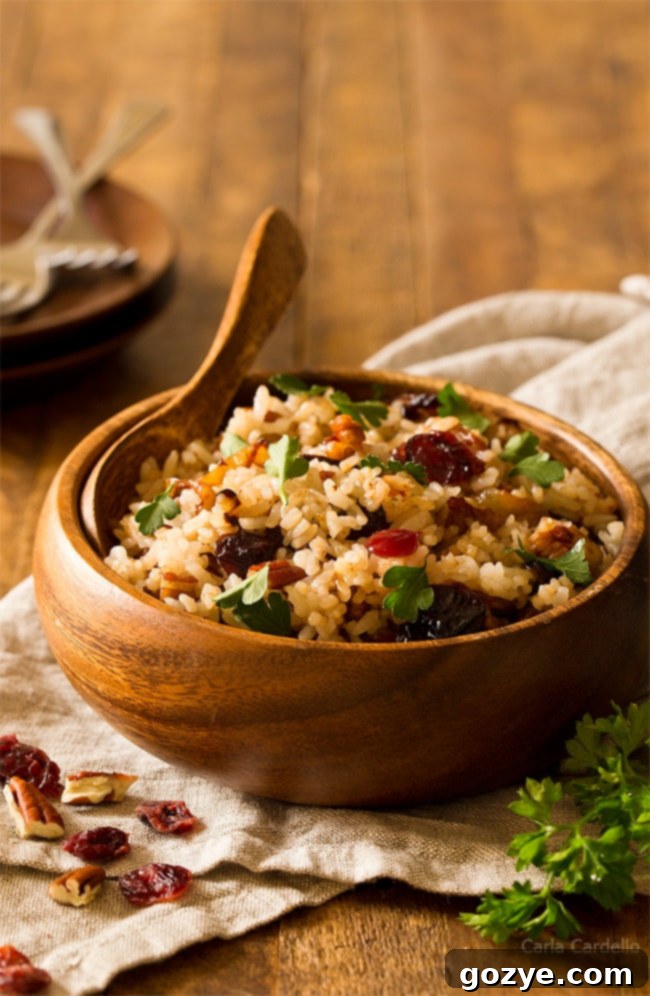Elevate Your Holiday Feast: Delicious Cranberry Rice Pilaf with Caramelized Onions and Pecans
Are you ready to say goodbye to bland, uninspired white rice? It’s time to transform your side dish repertoire with this incredibly flavorful Cranberry Rice Pilaf, expertly crafted with sweet, deeply caramelized onions and the delightful crunch of toasted pecans. This isn’t just a simple accompaniment; it’s a robust, aromatic, and truly satisfying dish that promises to be a star on your table. Perfect for festive occasions like Thanksgiving and Christmas, its hearty nature also makes it a fantastic vegetarian option that will impress everyone.
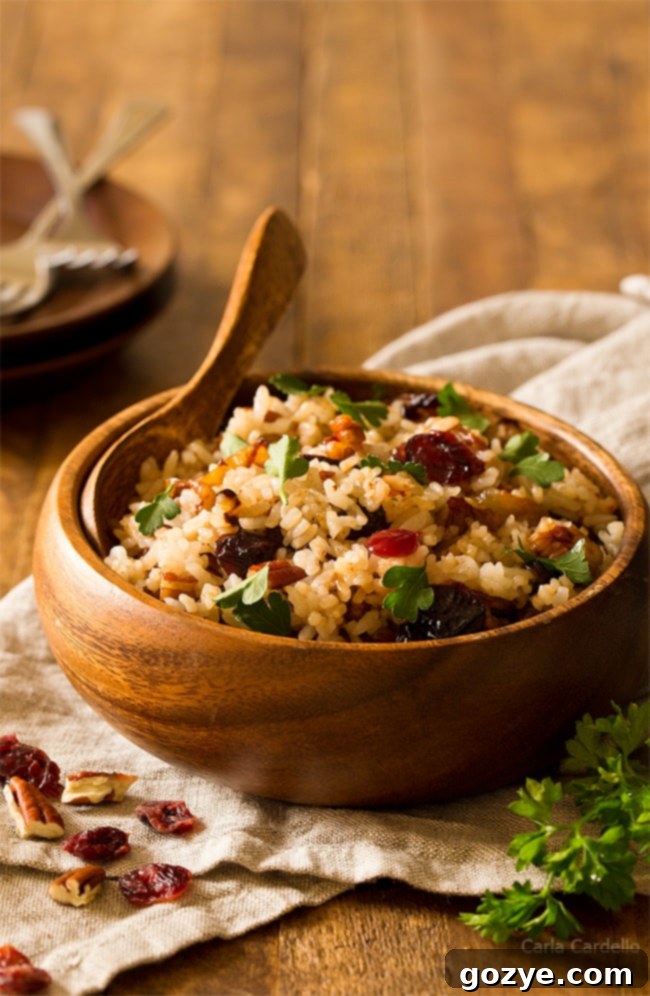
While we all cherish the joy of holiday sweets, like mastering the best Christmas cookie tray, there eventually comes a moment when our palates yearn for something savory and substantial. A balanced holiday feast ensures you’re not perpetually navigating a sugar-induced haze. That’s precisely why we’re turning our attention to a side dish that delivers profound, comforting flavors and stands as a testament to the versatility of humble ingredients.
One of the most frequent requests we receive from our readers is for more exciting and versatile side dishes. With the festive season well underway, what better way to celebrate than with a recipe that encapsulates the warmth and spirit of winter? This Cranberry Pecan Rice Pilaf is not only wonderfully festive but also surprisingly straightforward to prepare, making it an ideal companion for your holiday meals, including a grand Christmas dinner or a cozy, intimate gathering on a chilly winter evening.
The exquisite combination of sweet-tart cranberries, earthy pecans, and the rich, savory depth of caramelized onions creates a symphony of flavors and textures that truly embodies the essence of the holidays. This isn’t your average rice dish; it’s a luxurious, buttery, and toasty experience, punctuated by delightful hints of sweetness and a satisfying crunch in every forkful. It perfectly captures winter’s bounty, offering an elegant alternative to more traditional sides. It’s so good, you won’t even miss the candy canes!
This flavorful rice pilaf boasts incredible versatility. It serves as a beautiful complement to a wide array of main courses, from tender lamb chops for Christmas dinner to succulent honey mustard chicken thighs for a regular weeknight meal. Its hearty character ensures it pairs exceptionally well with almost any protein. For those seeking to transform it into a magnificent vegetarian main course, consider using this aromatic rice as a stuffing for Vegan Stuffed Butternut Squash – a truly impressive and satisfying dish.
Beyond Christmas, this Cranberry Rice Pilaf also excels as an outstanding vegetarian side dish for your Thanksgiving Dinner, offering a vibrant and fresh counterpoint to the rich, traditional flavors often found on the holiday table. It’s a dish that effortlessly brings comfort, joy, and a touch of gourmet flair to any occasion, making every meal feel special.
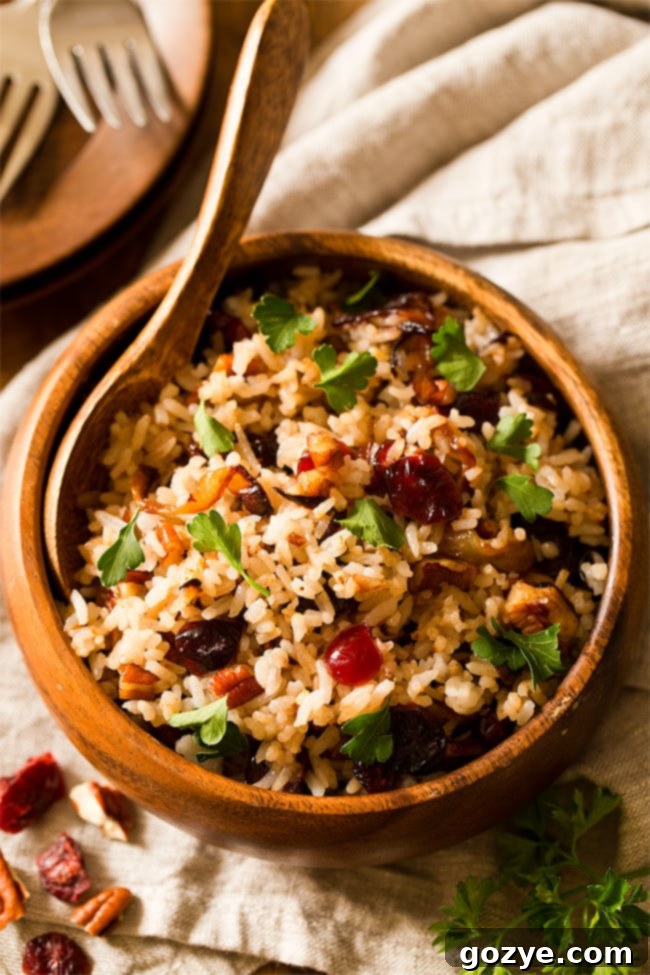
What is Rice Pilaf? Unpacking the Culinary Technique
At its core, rice pilaf is a culinary method that elevates simple rice into a side dish brimming with flavor and distinct character. The defining feature of pilaf is the initial step: toasting the dry rice grains in a fat, such as oil or butter, before they are simmered in liquid. This frying process, often referred to as “sautéing” or “toasting,” creates a subtle, protective barrier around each grain. This critical step helps prevent the rice from becoming sticky and mushy during cooking, resulting in perfectly separated, fluffy grains with a delightful texture and an enhanced, nutty flavor profile.
Historically, pilaf dishes boast a rich heritage, with roots deeply embedded in Central Asian, Middle Eastern, and South Asian cuisines. In these cultures, pilaf is often a central component of many traditional meals, revered for its ability to infuse rice with richer flavors and ensure a superior texture compared to plain boiled rice. While the specific ingredients can vary immensely across different regions and traditions – from exotic spices like saffron and fragrant dried fruits to various meats and vegetables – the fundamental method of toasting the rice and then simmering it in a flavorful broth remains the consistent heart of the technique.
The Distinct Difference: White Rice vs. Rice Pilaf
Many home cooks often wonder about the fundamental distinction between preparing regular white rice and crafting a flavorful rice pilaf. The answer lies directly in the cooking technique employed and the subsequent depth of flavor and texture achieved.
- Regular White Rice: This method typically involves boiling rice directly in water until the liquid is absorbed and the grains become tender. The result is a neutral, mild flavor profile, which makes it an excellent “blank canvas” for pairing with saucy dishes. It’s ideal for meals where the accompanying sauce is the undisputed star, such as my vibrant Spicy Beer Shrimp, allowing the sauce’s complex nuances to shine without competition from the rice itself. Its simplicity is its strength in specific culinary contexts.
- Rice Pilaf: In contrast, rice pilaf adopts a more flavor-intensive approach right from the start. The uncooked rice grains are initially sautéed in a fat – commonly butter or oil – for a minute or two until they appear slightly translucent or lightly toasted. This crucial “pilafing” step not only imparts a wonderful nutty aroma and flavor to the rice but also helps each grain to cook individually, effectively preventing clumping. Following this, aromatic ingredients like onions and garlic are often added and sautéed, before the rice is simmered in a rich, flavorful liquid such as vegetable or chicken broth (or stock), rather than just water. This strategic combination of initial frying and subsequent cooking in a seasoned liquid imbues the rice with significantly more depth, complexity, and inherent flavor, transforming it into a standalone side dish that actively contributes to and elevates the meal’s overall experience.
In essence, if your goal is a humble, absorbent accompaniment to a bold sauce, regular white rice is your go-to. However, if you’re seeking a side dish that brings its own robust character and enhances the entire meal with every spoonful, rice pilaf is undoubtedly the superior and more rewarding choice.
Mastering the Art of Caramelizing Onions for Deeper Flavor
One of the true, unsung heroes that elevates this Cranberry Rice Pilaf to gourmet status is the caramelized onion. Its deeply sweet, savory, and umami-rich flavor introduces an unparalleled layer of complexity that simply cannot be achieved with merely sautéed onions. The secret to crafting perfectly caramelized onions lies in unwavering patience and a commitment to a low-and-slow cooking process.
Resist all urges to rush this foundational step; this is where profound flavor development occurs. Begin by melting unsalted butter in a large skillet over *very low* heat. Once the butter is gently bubbling, add your thinly sliced onions along with a generous pinch of salt. The salt is crucial here, as it helps to draw out moisture from the onions, thereby facilitating the caramelization process. Cook the onions slowly, stirring gently every few minutes, for an extended period of approximately 20-30 minutes. You will observe them gradually softening, transitioning from an opaque white to a beautiful golden-brown, and eventually transforming into a rich, glistening amber hue. During this time, their natural sugars will intensely caramelize, transforming their initially pungent raw flavor into something incredibly sweet, deeply savory, and irresistibly rich. It’s imperative to resist the temptation to increase the heat, as this will only lead to burning the onions rather than allowing them to properly caramelize. This dedication to low-and-slow cooking is absolutely worth every minute, as it unlocks an incredible depth of flavor that will fundamentally elevate your entire dish.
And consider yourself warned: you might find yourself “taste testing” more than a few spoonfuls during the process! It’s an entirely acceptable culinary indulgence, and many find it wise to prepare a double batch – you’ll undoubtedly thank yourself later for the extra deliciousness.
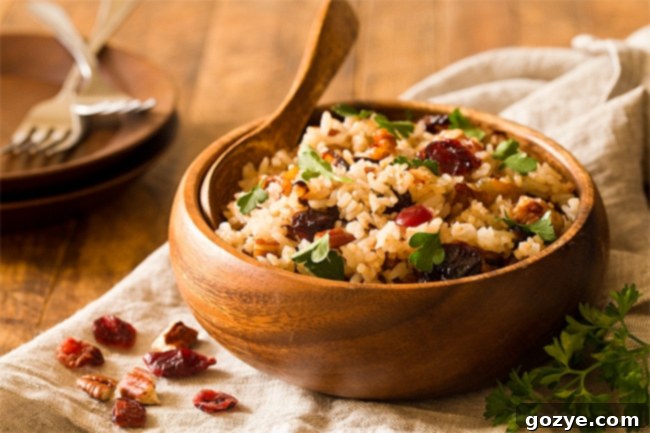
Step-by-Step Guide: Crafting Your Delicious Cranberry Rice Pilaf
Creating this flavorful and festive rice pilaf is a straightforward and rewarding process, especially once you’ve mastered the art of caramelizing onions. Follow these detailed steps to achieve a perfect, fluffy, and aromatic outcome:
- Caramelize the Onion: Begin by preparing your caramelized onions as meticulously described in the previous section. In a large skillet over low heat, melt the unsalted butter. Add your thinly sliced onion and a generous pinch of salt. Cook patiently for 20-30 minutes, stirring occasionally, until the onions achieve a deep golden-brown and are wonderfully sweet and caramelized. This foundational step is absolutely critical for the pilaf’s rich, complex flavor.
- Toast the Rice: Once your onions are perfectly caramelized, add the dry long white rice directly to the same skillet. Increase the heat slightly to medium-low and cook, stirring constantly to ensure even toasting, for about 1 minute. The rice grains should turn translucent around the edges. This vital toasting step is essential for developing a subtle nutty flavor and guaranteeing fluffy, separate grains in the final dish, preventing them from clumping together.
- Simmer with Flavor: Slowly and carefully pour in the vegetable or chicken broth. Then, gently stir in the dried cranberries and the specified amount of salt. Cooking the dried cranberries directly in the broth is a brilliant technique; it allows them to rehydrate and plump up beautifully as the rice cooks, simultaneously infusing the liquid with their delightful sweet-tart essence. There’s no need for any separate pre-soaking step!
- Bring to a Boil and Cover: Increase the heat to medium and bring the broth mixture to a gentle, rolling boil. As soon as it begins to boil vigorously, immediately reduce the heat to its lowest possible setting. Tightly cover the pan with a well-fitting lid, ensuring no steam can escape, and let it simmer gently.
- Cook to Perfection: Allow the pilaf to cook undisturbed for approximately 10-12 minutes, or until you observe that all the liquid has been fully absorbed by the rice and the grains are tender to the bite. It is crucial to resist the temptation to lift the lid during this period, as the trapped steam is absolutely necessary for the rice to cook evenly and thoroughly.
- Rest for Fluffiness: This step is just as important as the actual cooking process, however challenging it may be to resist peeking! Once the rice has finished cooking, remove the pan from the heat but keep it tightly covered with the lid. Let it sit and rest for a crucial 10 minutes. This essential resting period allows the steam to redistribute evenly within the rice grains, resulting in an exceptionally fluffier texture and giving all the wonderful flavors ample time to meld and deepen even further.
- Fluff and Finish: Finally, carefully remove the lid and gently fluff the rice with a fork. Avoid stirring too vigorously, which can break the grains. Stir in the chopped pecans, which add a delightful crunch and nutty flavor, and the fresh chopped parsley, which brightens the dish with a touch of herbaceous freshness and a pop of color. Taste the pilaf and adjust the salt if necessary, ensuring it meets your preference. Serve immediately and savor every delicious bite!
Perfect Pairings: What to Serve with Cranberry Rice Pilaf
This Cranberry Rice Pilaf is incredibly versatile and pairs wonderfully with an extensive array of main courses, effortlessly enhancing any meal with its vibrant, complex flavors and delightful textures. Here are some thoughtfully curated ideas for complementary dishes:
- Poultry Perfection: It’s an absolutely fantastic match for roasted chicken, succulent turkey breast, pan-seared duck, or even simple baked chicken. The harmonious sweet and savory notes of the pilaf beautifully complement the rich, sometimes subtle, flavors of various poultry. Consider serving it alongside our tender Honey Mustard Chicken Thighs for an irresistible and comforting combination.
- Robust Red Meats: For a more substantial and robust meal, pair this pilaf with savory lamb chops, a tender pork roast, or even an elegant beef tenderloin. The bright cranberries and deeply caramelized onions act as a delightful counterpoint, cutting through the richness of the meat and creating a perfectly balanced bite that tantalizes the taste buds.
- Elegant Fish Dishes: While often associated with poultry or red meats, this pilaf can surprisingly elevate certain fish dishes to new heights. It would be particularly delightful with baked salmon, especially if seasoned with herbs that echo the pilaf’s profile, or a delicate, mild white fish like cod or halibut, offering a refreshing contrast.
- Hearty Vegetarian Mains: As previously highlighted, this pilaf makes a superb and satisfying filling for Stuffed Butternut Squash or other roasted vegetables. It can also function as a complete and hearty vegetarian meal when served alongside a substantial lentil loaf, a rich mushroom ragout, or even flavorful roasted portobello mushrooms. For a lighter vegetarian option, pair it with crisp, vibrant roasted asparagus or tender green beans.
Preparing Ahead: Making Cranberry Rice Pilaf for Busy Schedules
Holiday cooking, while joyous, can often be a whirlwind of activity and tight schedules. Thankfully, this Cranberry Rice Pilaf recipe lends itself beautifully to partial preparation in advance, saving you valuable time and reducing stress on the big day. The most time-consuming component, and thus the most ideal to tackle ahead of time, is the caramelized onion.
You can meticulously cook the caramelized onions 1-2 days before you plan to serve your meal. Once they have cooled completely to room temperature, transfer them into an airtight container and store them in the refrigerator. When you’re ready to assemble the rest of the pilaf, simply retrieve the prepared onions from the fridge and seamlessly proceed with the recipe from the step where you add the rice. This small but significant act of foresight considerably streamlines your active cooking time on the day of your event, allowing you to dedicate more attention to other intricate dishes, or simply to relax and enjoy the company of your guests.
Short on Time? A Quick Onion Alternative: We understand that life happens, and caramelizing onions might feel like too much of a time commitment on particularly busy days, especially for a spontaneous weeknight meal. In such instances, there’s a quick and practical alternative: instead of thinly slicing the onion, dice it finely. Then, sauté the diced onion in butter or oil for approximately 5-8 minutes until it softens and becomes translucent. While this method won’t yield the same deep, complex sweetness and umami richness of fully caramelized onions, it will still provide a pleasant aromatic base and a foundational flavor to your pilaf, ensuring your dish is still delicious and well-rounded.
Why You’ll Fall in Love with This Cranberry Rice Pilaf
This isn’t merely another rice dish; it’s a culinary experience waiting to unfold and delight. Here’s why this Cranberry Rice Pilaf is destined to become a cherished and frequently revisited recipe in your culinary repertoire:
- An Explosion of Harmonious Flavors: Prepare for a sensory delight! The exquisite blend of sweet-tart cranberries, nutty, aromatic pecans, and the rich, umami depth of caramelized onions creates a complex and incredibly harmonious flavor profile that will tantalize your taste buds. Each and every spoonful offers a delightful journey through sweet, savory, and earthy notes.
- A Symphony of Delightful Textures: From the perfectly fluffy, distinct grains of rice to the satisfying, resonant crunch of the pecans and the tender, juicy chewiness of the rehydrated cranberries, this pilaf masterfully presents an exciting textural contrast that keeps every single bite intriguing and enjoyable.
- Holiday Elegance with Everyday Simplicity: While this dish possesses an undeniable elegance, making it a sophisticated and show-stopping holiday side dish for Thanksgiving or Christmas, the actual preparation itself is surprisingly straightforward. This accessibility ensures it’s easy enough to incorporate into your regular weeknight dinner rotation, adding a touch of gourmet flair whenever you desire.
- Hearty and Vegetarian-Friendly: This pilaf proudly stands as a substantial and exceptionally flavorful vegetarian option that feels anything but an afterthought. It confidently holds its own as a standalone dish or serves as a magnificent accompaniment to a wide variety of plant-based main courses, appealing to all dietary preferences.
- Remarkable Versatility in Pairing: Its balanced and rich flavor profile allows it to pair effortlessly and beautifully with an extensive range of main dishes. Whether you’re serving poultry, robust red meats, or even delicate fish, this pilaf is a flexible and adaptable choice that enhances diverse menus and satisfies various palates.
- Fantastic Make-Ahead Potential: The invaluable ability to prepare the time-consuming caramelized onions in advance significantly streamlines your cooking process. This is especially advantageous during the often-frenzied holiday seasons, allowing for a much more relaxed and enjoyable culinary experience.
Ingredient Spotlight: The Stars of Your Pilaf
Each ingredient thoughtfully selected for this Cranberry Rice Pilaf plays an indispensable and crucial role in achieving its overall success, vibrant flavor, and delightful texture:
- Unsalted Butter: The very foundation of flavor in this pilaf. Butter is utilized both for patiently caramelizing the onions and for expertly toasting the rice, contributing a rich, creamy base that profoundly enhances and rounds out all the other flavors present in the dish.
- Onion (White or Yellow): The true unsung hero that transforms this dish. When slow-cooked to perfection, it undergoes a magical transformation into a sweet, deeply savory, and intensely flavorful caramelized ingredient, adding a profound depth of character that truly defines the essence of this pilaf.
- Long White Rice: The meticulously chosen base for this pilaf, specifically for its inherent ability to cook up wonderfully fluffy and ensures individual, separate grains. While long white rice is specified, varieties like Basmati or Jasmine rice can also be used beautifully, each offering their own subtle aromatic qualities. It is advisable to avoid short-grain sticky rice for pilaf, as it will not yield the desired texture.
- Vegetable or Chicken Broth/Stock: This is where the pilaf truly gets its savory backbone and fundamental flavor. Opting for a high-quality vegetable or chicken broth instead of plain water is paramount, as the broth infuses the rice with a much richer, more complex flavor right from the start, exquisitely complementing all the other delightful ingredients.
- Dried Cranberries: These jewel-toned berries are much more than just a garnish; they bring a delightful burst of tartness and a complementary sweetness that beautifully cuts through and balances the richness of the caramelized onions and butter. When cooked directly in the broth, they rehydrate, plump up wonderfully, and become incredibly juicy.
- Salt: An absolutely essential seasoning that is critical for drawing out and enhancing the natural flavors of all the individual components. Remember to adjust the salt content carefully to your personal taste preference after the pilaf is cooked.
- Chopped Pecans: Added at the very end of the cooking process, pecans contribute their distinct, buttery, and earthy nutty flavor, along with a satisfying, essential crunch. This provides a crucial textural contrast that elevates the dish. Walnuts or slivered almonds could also serve as interesting and delicious substitutions for pecans.
- Fresh Chopped Parsley: A vibrant, herbaceous finish that not only adds a beautiful pop of fresh color but also introduces a clean, bright counterpoint to the rich, deep flavors of the pilaf. It brings a refreshing lightness to the dish.
Tips for Pilaf Perfection
To ensure your Cranberry Rice Pilaf is nothing short of spectacular and consistently achieves flawless results, keep these expert tips and tricks firmly in mind:
- Do Not Rush the Onions: This is arguably the most crucial tip for this entire recipe. The mantra for achieving truly magnificent caramelized onions is “low and slow.” Your patience at this stage will be immensely rewarded with an unparalleled depth of sweet and savory flavor that forms the backbone of the pilaf.
- Toast the Rice Properly: Ensure that each grain of rice is thoroughly coated in butter or oil and sautéed just until it begins to become translucent around the edges. This vital step prevents the rice from becoming mushy and significantly contributes to a desirable nutty aroma and flavor.
- Utilize Flavorful Broth: Always opt for a good quality vegetable or chicken broth. Avoid the temptation to use plain water, as the broth contributes significantly and fundamentally to the overall robust taste and complexity of the pilaf.
- Resist the Urge to Peek: Once the lid is securely on the pot, resist any temptation to lift it! Allowing steam to escape during the cooking process will prevent the rice from cooking evenly and thoroughly, potentially leading to undercooked or inconsistent results.
- The All-Important Resting Period: Under no circumstances should you skip the crucial 10-minute resting period after the rice has finished cooking. This allows the internal steam to redistribute perfectly throughout the grains, which is absolutely essential for achieving that coveted, wonderfully fluffy, and separate texture.
- Fluff Gently with a Fork: After the resting period, always use a fork to gently fluff the rice. Using a spoon can mash the delicate grains, compromising the texture, whereas a fork gracefully separates them, maintaining their integrity.
- Taste and Adjust Seasoning: Always take a moment to taste the finished pilaf before serving. Adjust the salt content as needed, and if you feel it could benefit from a little brightness, a tiny squeeze of fresh lemon juice can work wonders.
Storing and Reheating Your Delicious Leftovers
Should you be fortunate enough to have any leftover Cranberry Rice Pilaf – a rare occurrence given its deliciousness – proper storage and reheating techniques will ensure you can enjoy its delightful flavors again, maintaining its quality.
- Refrigerator Storage: Allow the cooked pilaf to cool completely to room temperature within two hours of preparation. Transfer it to an airtight container and store it in the refrigerator. It will remain fresh and delicious for up to 3-4 days.
- Freezing for Longer Term: For extended storage, you can successfully freeze the cooked pilaf. To do so, spread the cooled pilaf in a single, even layer on a baking sheet. This helps it cool quickly and prevents clumping. Once fully chilled, transfer it to freezer-safe bags or containers, ensuring you remove as much air as possible to prevent freezer burn. The pilaf can be frozen for up to 2-3 months. When ready to use, thaw it overnight in the refrigerator before proceeding to reheat.
- Effective Reheating Methods: To reheat, transfer the desired portion of pilaf to a microwave-safe dish. Add a tablespoon or two of extra broth or water to help rehydrate the rice and prevent it from drying out. Cover the dish loosely and microwave in 1-minute intervals, stirring gently between each interval, until it is thoroughly heated through. Alternatively, you can reheat it on the stovetop: place the pilaf in a covered skillet over low heat, adding a splash of liquid, and stir occasionally until warmed. Be cautious not to overcook, as this can lead to dry and less appealing rice.
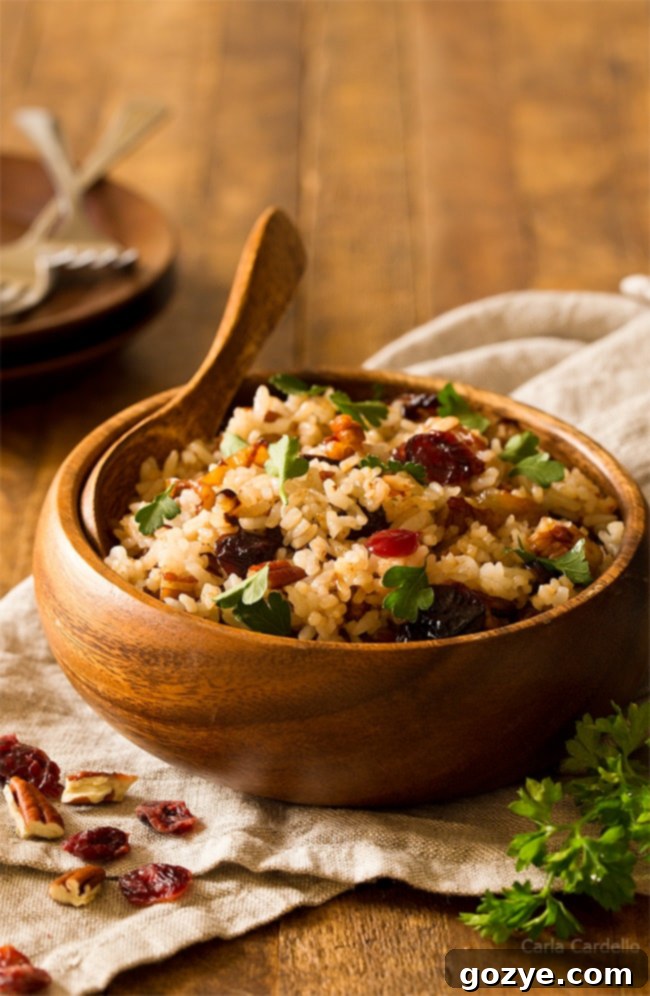
Cranberry Pecan Rice Pilaf with Caramelized Onion
4 servings
15 minutes
45 minutes
1 hour
Transform your holiday meals with this delicious Cranberry Pecan Rice Pilaf featuring sweet caramelized onions. No more bland side dishes – this hearty, vegetarian-friendly pilaf adds a burst of festive flavor and texture perfect for Thanksgiving, Christmas, or any special occasion. Its rich, buttery, and toasty profile, complemented by tart cranberries and crunchy pecans, makes it an unforgettable addition to your table.
Ingredients
- 2 tablespoons unsalted butter
- Half of a small white or yellow onion, thinly sliced*
- 1/2 cup dry long white rice
- 1 cup vegetable or chicken broth/stock
- 1/2 cup dried cranberries
- 1/4 teaspoon salt (plus a pinch for onions)
- 1/2 cup chopped pecans
- 1 tablespoon fresh chopped parsley
Instructions
- In a large skillet over low heat, melt the butter. Once melted, add the thinly sliced onion and a generous pinch of salt. Cook, stirring every few minutes, until the onions are deeply golden brown and caramelized, about 20-30 minutes. This slow cooking is key to developing their sweet, rich flavor.
- Add the dry rice to the skillet with the caramelized onions. Increase the heat slightly to medium-low and cook, stirring constantly, for about 1 minute until the rice grains turn translucent around the edges. This toasting step enhances their flavor and helps them cook up fluffy.
- Slowly stir in the broth, dried cranberries, and 1/4 teaspoon salt. Turn the heat up to medium and bring the mixture to a gentle boil.
- Once boiling, immediately reduce the heat to the lowest setting, cover the pan tightly with a lid, and let it simmer undisturbed for 10-12 minutes, or until all the liquid has been absorbed and the rice is tender. Avoid lifting the lid during this process.
- Remove the skillet from the heat, but keep the lid on. Let the pilaf rest for 10 minutes. This resting period is crucial for the rice to steam thoroughly and achieve a perfectly fluffy texture and for flavors to meld.
- Remove the lid, and gently fluff the rice with a fork. Stir in the chopped pecans and fresh chopped parsley. Taste and adjust salt if needed. Serve immediately and enjoy your flavorful holiday side!
Notes
*Time-Saving Tip for Holidays: To make this dish for Thanksgiving or Christmas without the last-minute rush, caramelize the onion 1-2 days ahead of time. Once cooled, store them in an airtight container in the refrigerator until you are ready to proceed with the rest of the recipe.
*Quick Onion Option: If you don’t have time to caramelize the onions, dice the onion instead of slicing. Sauté the diced onion in butter until it softens and becomes translucent, about 5-8 minutes, before adding the rice. This will provide an aromatic base, though with less depth of flavor than fully caramelized onions.
*Yield Adjustment: This recipe yields 4 servings as a side dish. To scale up for a larger crowd, simply double the ingredients and ensure you use a sufficiently large pan.
Did you make this recipe?
Let me know what you think! Rate the recipe above, leave a comment below, and/or share a photo on Instagram using #HITKrecipes
